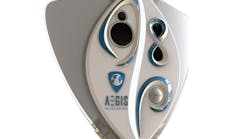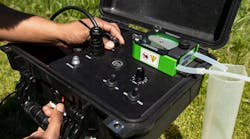A 2013 study conducted by Allsup, a provider of Social Security disability insurance, found that foundries ranked third among the most dangerous jobs in the United States.1
In foundries, danger is everywhere. According to the Occupational Safety and Health Administration (OSHA), between 2004 and 2015, there were 20 injuries or deaths caused by die-cast machines.2 To prevent these types of accidents, many facilities utilize heavy metal plate systems that when stepped on, trigger a switch to shut down the machine. However, these systems are often complex and can wear down over time. Individuals overseeing plant safety need to understand the variety of solutions available to protect workers and reduce equipment downtime. Industrial safety mats provide the durability and reliability for a foundry’s machine safeguarding needs.
THE HIGH COST OF HEAVY MACHINERY
The foundry work environment presents dangerous conditions, particularly around furnaces and other equipment used in the production of metal castings. But perhaps the best known cause of fatality and
injury is being caught in machinery. Employees are most often crushed by machinery that has been improperly locked and tagged out.
On February 15, 2016, a 57-year-old worker was crushed by a 4,000-lb. machine part as he performed maintenance inside of a core machine, and later died from his injuries. In 2012, a 50-year-old man died while repairing a hydraulic tabletop in an Alabama cast-iron foundry’s mold department.4
An employer’s responsibility of protecting workers carries with it the potential for serious legal consequences and fines for the organization if it fails to properly protect its workers. OSHA 1910.212 requires one or more methods of machine guarding shall be provided to protect the operator and other employees in the machine area from hazards such as those created by point of operation, ingoing nip points, rotating parts, flying chips and sparks. After an investigation, OSHA fined the Alabama company $105,000.3
WORN OUT SOLUTION
According to OSHA, the leading cause of deaths in foundries is being stuck or crushed by machinery. To protect employees operating molding machines, many machines use steel plates that rest on large springs. When an employee steps on the on the plate, it compresses the springs, triggering a limit switch that’s connected to a safety control unit. A limit switch is designed to stop the process without causing damage to the product and equipment or
injury to the operator.
However, dust and debris can build up on the springs, causing them to become stuck. As a result, the limit switch remains engaged, preventing the machine from running. Ultimately, this results in unplanned downtime, which can cost a company thousands in lost productivity. Additionally, the steel plates that rest on the springs can become warped over time, which can prevent them from pressing down on the springs to safely stop a machine.
LAYING DOWN A SAFER SOLUTION
Although all accidents cannot be avoided, some can be prevented. There is a safer and simpler solution for facilities rather than using the complex steel plate system. Industrial safety mats have a high sensitivity threshold, requiring
only 5-10 pounds for activation. If someone steps on the mat, the control unit signals the machine to stop, even if it’s in the middle of a cycle. No springs are required. If someone is standing on the mat and they try to start the machine manually, the machine will not start. In order to start the machine, the individual must step off the mat and press the reset button, followed by the start button to engage the machine, reducing the risk of injury.
Industrial safety mats are also more dependable than the steel plate system. Certain industrial safety mats are impact resilient, abrasion resistant and totally submersible. It’s important for a safety manager to research the available options and only purchase mats from a reputable manufacturer. They should look for mats that meet or exceed the industry standards including OSHA 1910.212 and ANSI B11.19.
Case Study
LARCO HELPS ATEK METAL TECHNOLOGIES STEP UP SAFETY AND REDUCE EQUIPMENT DOWNTIME
For more than 50 years, ATEK Metal Technologies has manufactured aluminum castings for a variety of demanding industries, including motorsports and recreation, transportation, agriculture and industrial markets. To protect employees operating its molding machine, ATEK Metal Technologies used a steel plate that sat on four-inch tall springs designed to shut the machine down when an employee stepped on the plate. The plate would compress the springs onto four limit switches that were wired to a safety control unit which would stop the molding machine immediately. However, over time, the steel plates became warped and the springs would stick frequently, forcing employees to adjust the limit switches after compression in order to get the molding machine running again.
“Consistency was a problem with the old system,” said Joel Stravers, maintenance supervisor at ATEK Metal Technologies. “We lost valuable time constantly adjusting the limit switches so they would create contact with the plate and get the machine running again.”
Safety was a major concern for ATEK Metal Technologies. If a worker stepped on the steel plate, but the switch didn’t engage, the worker could be seriously injured.
“If someone’s arm was caught in the machine when it came down, it could result in a serious injury or someone could potentially lose their arm,” said Stravers. “We were fortunate to never have an employee injured by the molding machine, but we knew we needed a safer option.”
STEPPING UP SAFETY
In late 2015, the company turned to ATEK Access Technologies for its Larco industrial safety mat and safety controller. Larco industrial safety mats have a high sensitivity threshold, requiring only 5-10 pounds for activation in normal foot traffic. If an operator steps on the Larco mat, the control unit signals the molding machine to stop, even if it is in the middle of the cycle. If the operator steps off the mat, they can press the reset button and then the start button to engage the machine. If they’re standing on the mat and they manually try to start the machine, the machine will not start, reducing the risk of injury.
Designed to meet the most stringent industrial requirements, Larco industrial safety mats offer a long-lasting solution to machine guarding needs. Larco mats are extremely durable, impact resilient, abrasion resistant, totally submersible and can withstand heavy forklift traffic.
“We considered using light curtains and lasers, as well as other types of limit switches, but none gave us the flexibility and durability that the Larco industrial safety mat does,” said Stravers. “The Larco mat holds up to the heat, dust and dirt in the foundry.”
SAFETY SAVES VALUABLE MAINTENANCE HOURS
Since installing the Larco industrial safety mat, ATEK Metal Technologies has realized numerous benefits.
“We’ve been able to dramatically reduce equipment downtime, saving valuable maintenance hours,” said Stravers.
ATEK Metal Technologies has also enhanced employee safety at the molding machine point-of-operation. If an employee is standing on the Larco mat, the machine will not run, reducing the risk of injury.
“Our main goal was to improve safety, and the Larco industrial mat provides the consistency we were missing,” said Stravers. “Thanks to the durability of the Larco mat, our employees never have to worry about the molding machine engaging while they’re standing on the mat.”
GREATER PEACE OF MIND
No matter the facility, safety is the first priority. An overall culture of safety is required to eliminate life-taking mishaps around a manufacturing plant. By replacing worn out steel plates with industrial safety mats, foundry facilities can prevent accidents, promote safety and reduce downtime. They also provide peace of mind for workers in a dangerous industry.
1 Allsup. “Allsup Study of Workplace Injuries.” www.allsup.com. 23 July 2013.
2 https://www.osha.gov/pls/imis/AccidentSearch.search?acc_keyword=%22Die%20Casting%20Machine%22&keyword_list=on
3 http://www.foundrymag.com/moldscores/osha-cites-foundry-following-accident-death
4 http://www.pbs.org/wgbh/frontline/article/osha-investigating-worker-death-at-mcwane-foundry/
Authored by Scott Garden - Senior Product Manager - Larco
ATEK Access Technologies, LLC.








